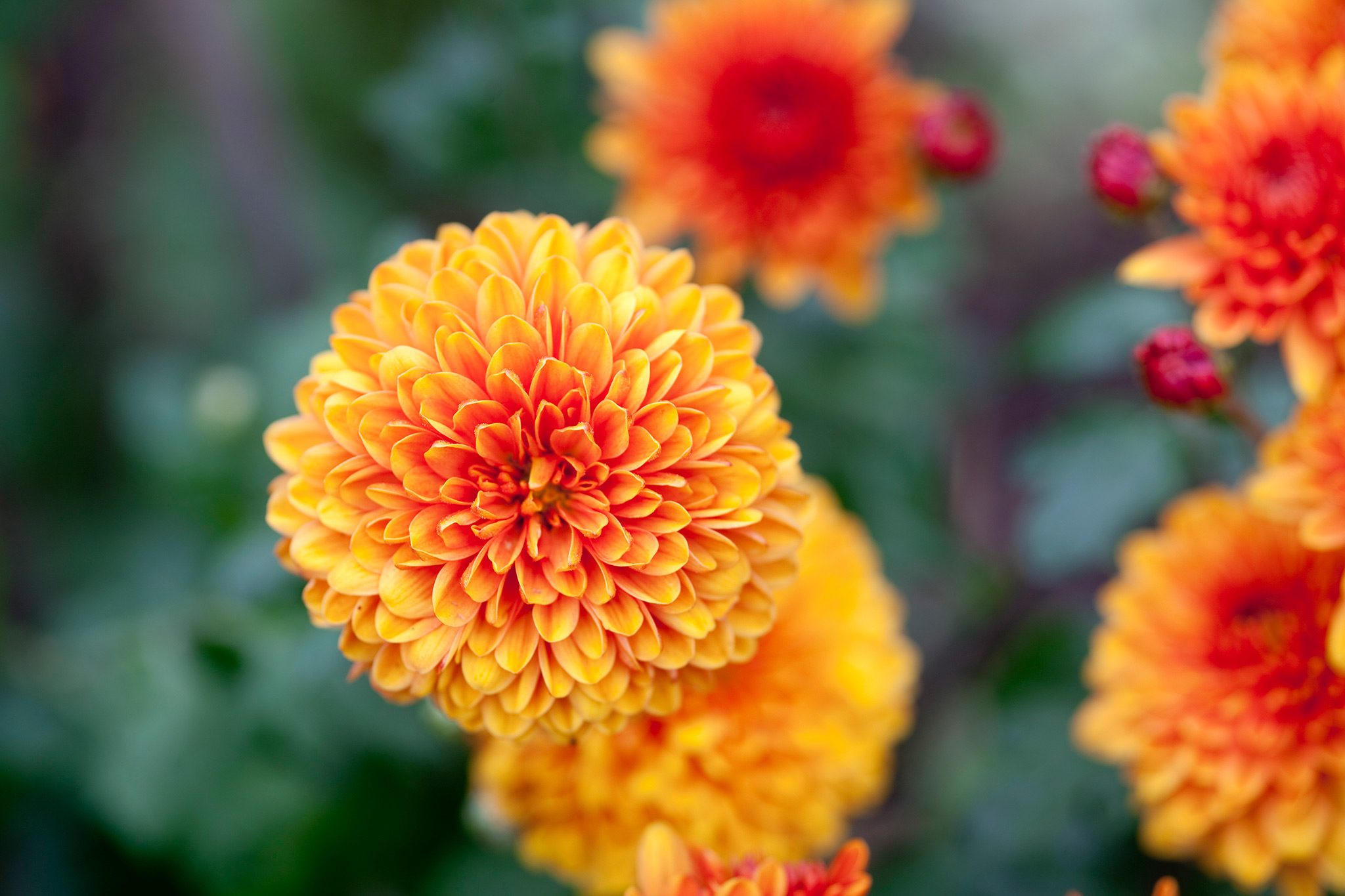
Chrysanthemums, commonly known as “mums,” are an enchanting and versatile plant that has captivated gardeners and flower enthusiasts for centuries. With their vibrant colors and unique petal formations, chrysanthemums have become a cherished addition to gardens, floral arrangements, and even tea infusions. But there is so much more to these remarkable flowers than meets the eye.
In this article, we will uncover 17 astonishing facts about chrysanthemums that will leave you in awe of their beauty and diversity. From their rich cultural symbolism to their medicinal properties, you’ll discover why chrysanthemums are more than just a pretty face. So, prepare to be amazed as we delve into the fascinating world of these remarkable blooms.
Key Takeaways:
- Chrysanthemums are more than just pretty flowers – they symbolize happiness, have antioxidant properties, and are used in traditional medicine. They’re also the birth flower for November, making them a meaningful gift for November birthdays.
- Chrysanthemums come in a stunning array of colors and flower forms, making them a versatile choice for floral arrangements and garden displays. They also have a long vase life and are popular in bonsai cultivation, adding beauty and artistry to any space.
Chrysanthemums symbolize happiness and longevity.
Chrysanthemums, commonly known as mums, are revered for their symbolism of positivity, joy, and longevity in many cultures around the world. These flowers are often associated with celebrations and are believed to bring good luck and prosperity.
Chrysanthemums come in a wide array of colors.
From vibrant reds and oranges to soft pinks and purples, chrysanthemums showcase a stunning spectrum of colors. With over 40 different species and thousands of varieties, these flowers offer endless options for floral arrangements and garden displays.
Chrysanthemums have a rich cultural history.
The origin of chrysanthemums can be traced back to ancient China, where they were cultivated for their medicinal properties. They later made their way to Japan, where they became the national flower and are prominently featured in traditional art, festivals, and even the Japanese Imperial Family’s crest.
Chrysanthemums have various meanings in different cultures.
In Japan, chrysanthemums are associated with the autumn season and represent the virtues of nobility and honor. In Chinese culture, they are regarded as a symbol of perfection and are often used in ceremonies and offerings.
Chrysanthemums have been cultivated for over 2,500 years.
The cultivation of chrysanthemums dates back to ancient times, with records of their cultivation in China as early as the 15th century BCE. Throughout history, these flowers have been selectively bred for their desired characteristics, resulting in the incredible variety we see today.
Chrysanthemums have powerful antioxidant properties.
Studies have shown that chrysanthemums contain compounds with antioxidant properties, which may help protect against oxidative stress and promote overall health. These antioxidants have been linked to various health benefits, including reducing inflammation and supporting immune function.
Chrysanthemum tea is a popular beverage in many cultures.
Chrysanthemum tea, made from the flowers of the plant, is a popular beverage in many Asian countries. It is known for its delicate floral aroma and refreshing taste. The tea is often enjoyed for its potential health benefits, such as improving digestion, reducing anxiety, and promoting relaxation.
Chrysanthemums come in different flower forms.
Chrysanthemums exhibit a range of flower forms, including daisy-like blooms, spider-shaped petals, and pompon-like clusters. Each form offers a unique aesthetic appeal, making chrysanthemums a versatile choice for floral arrangements and garden design.
Chrysanthemums are used in traditional medicine.
In traditional Chinese medicine, chrysanthemums are believed to have cooling properties and are used to treat various ailments such as headaches, high blood pressure, and inflammation. The flowers are often steeped in hot water to create medicinal teas or incorporated into herbal remedies.
Chrysanthemums are a favorite flower for autumn decorations.
In many parts of the world, chrysanthemums are synonymous with fall and are widely used in seasonal decorations. From festive centerpieces to vibrant wreaths, these flowers add a touch of beauty and warmth to autumnal displays.
Chrysanthemums are known for their long vase life.
One of the remarkable qualities of chrysanthemums is their ability to last a long time in a vase. With proper care, these flowers can stay fresh for up to two weeks, making them an excellent choice for floral arrangements and bouquets.
Chrysanthemums are the birth flower for November.
If you were born in November, chrysanthemums are your birth flower. These blooms are often associated with the qualities of loyalty, love, and friendship, making them a meaningful gift for November birthdays.
Chrysanthemums are popular in bonsai cultivation.
Chrysanthemums are frequently cultivated as bonsai trees, utilizing their natural beauty and ability to adapt to confined spaces. The intricate pruning and shaping of these miniature chrysanthemum trees create stunning artistic expressions of nature.
Chrysanthemums have medicinal uses.
Aside from their traditional medicinal applications, chrysanthemums have been studied for their potential therapeutic benefits. Extracts from chrysanthemum flowers have been found to possess antimicrobial, anti-inflammatory, and anticancer properties in scientific research.
Chrysanthemums are widely grown and appreciated in the United States.
In the United States, chrysanthemums are cherished for their vibrant colors and contribution to autumn floral displays. They are favored for their hardiness and ability to withstand cooler temperatures, which makes them a popular choice for fall gardens.
Chrysanthemums have been bred to resist pests and diseases.
Through selective breeding, horticulturists have developed chrysanthemum varieties that exhibit natural resistance to common pests and diseases. This characteristic makes them easier to grow and reduces the need for excessive pesticide use in cultivation.
Chrysanthemums have a distinct fragrance.
Many chrysanthemum varieties emit a subtle yet distinctive aroma, which adds to their overall appeal. The fragrance can vary from mild and floral to slightly spicy or herbal, enhancing the sensory experience when enjoying these beautiful flowers.
These 17 astonishing facts about chrysanthemums highlight their cultural significance, natural beauty, and potential health benefits. Whether you admire them as decorative blooms, enjoy their tea, or appreciate their symbolism, chrysanthemums undoubtedly hold a special place in our hearts and gardens.
Conclusion
Chrysanthemums are truly remarkable flowers with a rich history and an array of fascinating characteristics. From their diverse range of colors and shapes to their symbolic meanings in different cultures, these blooms have captivated people for centuries. Whether used for decorative purposes, herbal remedies, or even culinary delights, chrysanthemums continue to be revered for their beauty and versatility.
With their ability to thrive in various climates and their importance in festivals and traditions around the world, it’s no wonder that chrysanthemums hold a special place in the hearts of many. So next time you come across these vibrant flowers, take a moment to appreciate the astonishing facts that make them so extraordinary.
FAQs
1. Are chrysanthemums easy to grow?
Yes, chrysanthemums are relatively easy to grow. They prefer well-drained soil, ample sunlight, and regular watering. With proper care and attention, you can enjoy a beautiful display of chrysanthemum blooms in your garden.
2. Do chrysanthemums have any medicinal properties?
Indeed, chrysanthemums have been used in traditional medicine for centuries. They are believed to have various health benefits, including reducing inflammation, improving digestion, and boosting the immune system.
3. Can chrysanthemums be eaten?
Yes, certain varieties of chrysanthemums can be consumed. In some Asian cuisines, chrysanthemum petals are used in teas, salads, and stir-fries. However, it is essential to ensure that the specific variety being used is safe for consumption.
4. Are chrysanthemums symbolic of anything?
Absolutely, chrysanthemums hold significant symbolic meanings in various cultures. In many countries, they are associated with joy, happiness, longevity, and rebirth. In Japan, chrysanthemums are the symbol of the Emperor and the Imperial Family.
5. Can chrysanthemums survive in colder climates?
Yes, some chrysanthemum varieties are hardy and can withstand colder temperatures. These types are typically known as “garden mums” and can survive even in frosty conditions. However, it is still important to provide proper winter protection.
Chrysanthemums captivate with their astonishing qualities, but there's even more to explore. Uncover mindblowing facts that will leave you in awe of these stunning blooms. Delve into unbelievable details about chrysanthemums' rich history and cultural significance. For a fascinating journey through the world of chrysanthemums, check out the story behind the classic Japanese film that pays homage to this beloved flower.
Was this page helpful?
Our commitment to delivering trustworthy and engaging content is at the heart of what we do. Each fact on our site is contributed by real users like you, bringing a wealth of diverse insights and information. To ensure the highest standards of accuracy and reliability, our dedicated editors meticulously review each submission. This process guarantees that the facts we share are not only fascinating but also credible. Trust in our commitment to quality and authenticity as you explore and learn with us.


